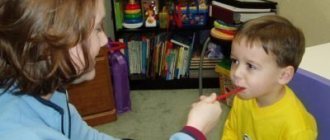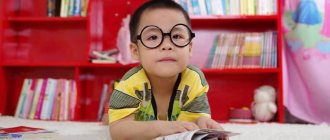Children's fears and age
- At 2-3 years old, the baby associates sharp sounds with danger; this cause of fear in young children is extremely common.
- Not all parents fully understand how painful the eternal fear of the dark can sometimes be for a child.
- Many children are instinctively afraid of pets, especially unfamiliar ones, until they get used to them.
- The causes of fear in children from 4 years of age are often associated with developing imagination. A child may be frightened by characters in computer games and films, shadows, dreams, or his own embodied fantasies.
- Fears grow with children, especially quickly if the kids are faced with grief in the family. Already from the age of 5, a small person can be afraid of becoming terminally ill, losing a loved one, or dying.
Working with preschooler's fears
Zoya Olegovna Airapetyan
Working with preschooler's fears
Working with preschooler's fears
Goal: Correction of children's fears .
One of the reasons for the emergence of fears in preschoolers is a highly developed imagination, and also the fact that at this age cause-and-effect relationships begin to arise in their minds, for example, a child may be afraid of the dark, since danger may be hiding there, and if it is not visible, then the baby thinks that he cannot protect himself.
Sometimes gifted children exhibit increased fears due to the fact that they have more developed imagination and intelligence. The child does not yet know how to correctly relate to all the incredible relationships that arise in his head.
to experience fears if they do not interfere with the child’s ability to play, make friends, and demonstrate age-appropriate independence. In other cases, the child needs the help of a psychologist and the support of loved ones.
Techniques for working with fear :
• Replaying a situation of fear
- by changing roles - imagine the child being afraid , experiencing his feelings and understanding that he, too, was once little, he himself was afraid of something...
- a game of hide and seek - the child must be the driver. That is, look for a frightened child (you are in the role of this child)
.
When the driving child finds a frightened adult child (role)
- he will feel his strength-courage
(consolidate it)
- play dress-up - literally dress in a costume of fear and reflect - say what fear feels , feels, what it feels like for him, how he “not scary "
within themselves and are not at all dangerous.
• Drawing fear .
Draw four pictures:
– draw your fear ,
- yourself with fear ,
- a fictional hero who conquers fear ,
- yourself as a hero - the conqueror of fear .
(if in the 1st picture the fear is huge , and the child is small and at the bottom of the sheet. Then in the last picture it’s the other way around).
Experiencing a scary situation with an adult (parent)
.
To help a child overcome fear , parents can use techniques for living through a scary situation together with an adult - for example, using a flashlight to examine the room where the baby is sleeping. Ask your child where his fear (usually under the bed or in a corner)
. Go to this corner in the dark with candles, look under the bed and ask if he sees something there. It is important that the child himself says that there is nothing there. Then we turn off the flashlight, warning the child in advance. Then turn on the flashlight and ask the child to turn it off and leave the room together. Then ask the child to come in alone with the door open. And so on until the child can freely do without light and an adult. It’s better to do this gradually:
– take your time, encourage the child, support and praise;
- treat the child with respect, trust, and faith in him.
Identify the cause of fear . The cause of fear may be a lack of attention, love, sympathy, encouragement, or care from parents. And this is the responsibility of the parents themselves! Ask yourself a question: do I spend enough time with my child, do I communicate with him well?
Preschool age is a period when children are completely dependent on adults; it depends on us how the child will cope with the difficulties that arise.
Diagnosis: fear
A child who trusts his parents will sooner or later tell what worries him. The main thing is to help him with this. To diagnose children's fears at home, you can use pictures from books and magazines with five types of images. Look for pictures that illustrate:
- fears of dangerous elements (fire, flood, storm, etc.);
- spatial fears and fears of the unknown (heights, depths, open or closed spaces; fear of getting lost in the forest, being left in complete darkness or being in fog);
- social fears (punishment, fear of strangers, loneliness);
- fear of animals and insects (wolves, dogs, snakes, spiders, wasps, etc.);
- fears-fantasies (characters of fairy tales, cartoons and children's horror stories passed on from mouth to mouth).
The main thing when choosing pictures is that they are not overly realistic. Pictures from adult newspapers and magazines are not suitable - such photographs “from the scene of the incident” can scare even parents, let alone children. Therefore, it is worth using old children's magazines or books. In them, both the vagaries of nature and evil wizards look a little comical, but at the same time quite recognizable.
When showing images to your child, watch his reaction and listen to the comments. So, unnoticed by himself, looking at the pictures, the baby will tell how and what exactly he was afraid of (“Such a dog, only black, rushed at Tanya, one uncle barely drove her away. We thought she would tear us apart!”). Perhaps the child will be brave in words (“I’ll crush this spider, and I’ll take the magician and cast a spell!”), but he himself will look frightened, his voice will tremble... Or the baby will look at all the pictures and say: “It’s not scary, much worse..." - and finally he will name out loud his fear, which none of his loved ones could even guess about, it seemed so ridiculous by the standards of his parents... The main thing here is not to laugh at the baby, not to call him a coward. It’s already hard for him, there’s no need to aggravate this condition. It is better to instill hope in him that together you will overcome any fear. And be sure to thank and praise the child for his frankness: after all, in order to admit your fear, you need to have enormous courage, which not even every adult is capable of.
Let's draw and heal!
When it becomes clear what exactly the baby is afraid of and why this is happening, you can invite him to... portray his fear. Both paints and pencils and plasticine are suitable for this. Don’t be surprised if after a few minutes bright flames or something black and shapeless appear on the sheet, and a monster with spikes and fangs is born from plasticine. Now the fear has spilled out, there has been a release of negative emotions, and the child feels better. And you can do anything with this fear - even tear it up, throw it in the garbage chute, or even burn it (naturally, under the supervision of adults).
But the best thing is to make this “horror” funny and cheerful. For example, on a sheet of paper where a fire is raging, draw brave beaver firefighters, and stick a clown nose on a plasticine scarecrow and give a bouquet of daisies in his hands. The baby will be convinced that the unknown is not a painful expectation, but a riddle that is interesting to solve. The ability to control fear and the awareness that it can be controlled are very important. You can depict a talisman - some kind creature that will drive fears away. For example, a good sorcerer with a magic wand. And then, even in a dark room, the baby will know that he has a protector.
Psychological and Pedagogical Center
Constant anxiety does not allow a child to feel comfortable and develop all his inclinations!
What is anxiety?
Anxiety is a fairly stable individual psychological feature, which consists of a person’s increased tendency to experience anxiety for a variety of reasons (or without them at all). Anxiety is typical for your child if he shows anxiety often and in a variety of situations: when meeting new people, answering at the board, doing homework, etc. At the same time, anxious children often cannot explain what exactly they are afraid of. If they know what they are afraid of, then we talk about fear (fear always has an object - a person, animal, object or situation).
How to determine?
In order to identify an anxious child, the following questionnaire is used (Lavrentyeva G.P., Titarenko T.M.). An anxious child: 1. Cannot work for a long time without getting tired. 2. It is difficult for him to concentrate on something. 3. Any task causes unnecessary anxiety. 4. While performing tasks, he is very tense and constrained. 5. Feels embarrassed more often than others. 6. Often talks about tense situations. 7. As a rule, blushes in unfamiliar surroundings. 8. Complains that he has terrible dreams. 9. His hands are usually cold and wet. 10. He often has upset bowel movements. 11. Sweats a lot when excited. 12. Doesn't have a good appetite. 13. Sleeps restlessly and has difficulty falling asleep. 14. He is timid and fears many things. 15. Usually restless and easily upset. 16. Often cannot hold back tears. 17. Does not tolerate waiting well. 18. Doesn't like to take on new things. 19. I am not confident in myself, in my abilities. 20. Afraid to face difficulties.
Add up the number of positives to get a total anxiety score. High anxiety - 15-20 points. Average - 7-14 points. Low - 1-6 points.
It is recommended to work with anxious children in three directions: 1. Increasing self-esteem. 2. Teaching the child the ability to control himself in specific, most worrying situations. 3. Relieving muscle tension.
How to help an anxious child?
Game "Piggy Bank of Achievements"
This is a game that should develop into the habit of seeing and appreciating your small victories every day. Take a box or jar and decorate it together with your child. Separately, prepare small pieces of paper. Introduce a rule: when the child returns home, he must remember and write on this piece of paper some evidence of the success he has achieved today. So, phrases will appear on the notes: “I read the poem well,” “I drew an excellent drawing on the theme “Autumn,” “I made a gift for my grandmother, which she really liked,” etc.. These notes are placed in the treasury of achievements. It is important that even in the most unfavorable day the child can find something that he succeeded in. You can turn to this piggy bank when it seems to the child that he has encountered difficulties that are insurmountable for him, or during periods when his critical gaze is directed at his abilities and he sees himself as a worthless loser. During such times, it is helpful to remember that your child has experience overcoming difficulties and achieving success.
Relieving muscle tension
For anxious guys, being able to relax is simply a necessity, because anxiety is accompanied by tension in various muscle groups, especially the face and neck. You can use relaxation exercises, deep breathing techniques, massage, and body rubs. Another way to relieve excessive anxiety is to paint your face with your mother’s old lipsticks, paint with your palms, etc.
Relaxation and breathing exercises “Fight”
Goal: relax the muscles of the lower face and hands. “You and your friend had a fight. A fight is about to start. Take a deep breath and clench your jaw tightly. Fix your fingers in your fists, press your fingers into your palms until it hurts. Hold your breath for a few seconds. Think about it: maybe it’s not worth fighting? Exhale and relax. Hooray! The troubles are over!
Game: “Tender chalk.”
There is good entertainment - drawing or writing on the back. The adult tells the child the following: “You and I will draw on each other’s backs. What do you want me to draw now? Sun? Fine". And with a soft touch of his fingers he depicts the outline of the sun. "It seems? How would you draw on my back or arm? Do you want me to draw the sun for you with “affectionate” chalk?” And an adult draws, barely touching the surface of the body. “Do you feel good when I draw like this? Do you want a squirrel or a fox to draw the sun with their “affectionate” tail? Do you want me to draw another sun, or moon, or something else?” After finishing the game, the adult, with gentle hand movements, “erases” everything he has drawn, while lightly massaging the back or other part of the body.
Exercise “Calm, just calm!”
In this game, the child will train to remain calm in a variety of situations, when scared or unexpected. He will later be able to use these gaming skills in everyday life. Ask your child to remember a simple, well-known poem. Now he will have to read it as calmly as possible, saying one line at a time, no matter what happens around him. And what will happen around you is something that you can come up with that is scary and unpleasant. Have your child start reading the first line. Let's say he says: “I was driving a Greek across the river.” Meanwhile, you will sneak up from behind and clap your hands. But the reader must calmly continue: “He sees a Greek: there is cancer in the river.” Then you can turn off the light or even unexpectedly push the child on the shoulder. In general, this way you will “mock the little one” until the last line of the poem. (it is important that the child understands that these actions are performed “not by you”, but by the chosen character, for example Freken Bock). Note. To make it easier to maintain the role of a calm person, you can remember Carlson and try to imagine how he would read this poem, showing everyone how calm he is...
Compiled by: ORP methodologist Tatyana Evgenievna Komarcheva
Is it in the closet?
The causes of fears must be sought in the world around the baby. The child’s psyche is very plastic, and any, even insignificant, event can leave an indelible mark on the child’s memory.
Perhaps the dog scared the baby during a walk (although she was just trying to “get to know” the baby and didn’t even bark). Or friends in kindergarten told a horror story about a black hand living under the bed... Or simply a bar of soap drowned in a barrel at the dacha, and the kid was already imagining God knows what.
Any of these events can unsettle a child for a long time. Especially if it coincides with a difficult period in the child’s life - for example, with the “three-year crisis” or with the divorce of parents (which in itself, of course, is already a stressful situation). Therefore, in order to recognize and then overcome fear, it is necessary to pay as much attention as possible to the baby and create a calm atmosphere in the house.
Fairy tale therapy sessions
But, of course, the best remedy for children's fears is a friendly atmosphere in the family and the attention of parents who are ready to explain any phenomenon in our lives and answer all the “whys” and “whys”. After all, when a child feels that he is not alone, that he will always be helped, he grows up calmer and more confident. Instead of hiding from the scary and nasty “byakizakalyak” lurking on the floor in a dark room, such a child will simply turn on the light and discover that it is just a toy that he forgot to put back in the evening. Most children's fears go away in the older preschool years - just before the child goes to first grade. But if the child has been afraid of something for many months, and even more so for years, then it is necessary to consult a specialist. And the sooner, the better, because old neuroses are difficult to correct.
Child psychologists have a variety of techniques for recognizing and combating phobias, and the sessions are fun and suitable for even the youngest patients. For example, many specialists use a sandbox when working with children. If the baby will play at home, then you will need a small box (70/60/15), half filled with clean sand. Place pebbles, shells, cones, twigs, flowers, figures of people, birds, fish, animals, fairy-tale characters, cubes, bridges, houses, cars in the box nearby. And give your child the opportunity to wet the sand with water so that he can build his own world.
Such sessions gently relieve fears, and the baby perceives them as a fun game. Just like fairy tale therapy. Fairytale therapy sessions are often used to combat childhood experiences and give good results. The fairy tale, without lecturing, conducts a serious conversation with children, conveys models of behavior in different situations when the characters are faced with a choice. Together with the characters of the fairy tale, the baby experiences and overcomes fear. The fairy tale gives hope that good will definitely triumph over evil in the end. She teaches empathy and compassion.
The heroes of a fairy tale always have clear moral guidelines: good or evil, good or bad. A positive hero is usually in a more advantageous, interesting and attractive position, so more often the child identifies himself with him.
After fairytale therapy sessions, children become more balanced, more inquisitive, and not only evil heroes, but also helping characters appear in their fantasies. This means that the child will gradually learn to fight his fears on his own and will definitely defeat them later!









